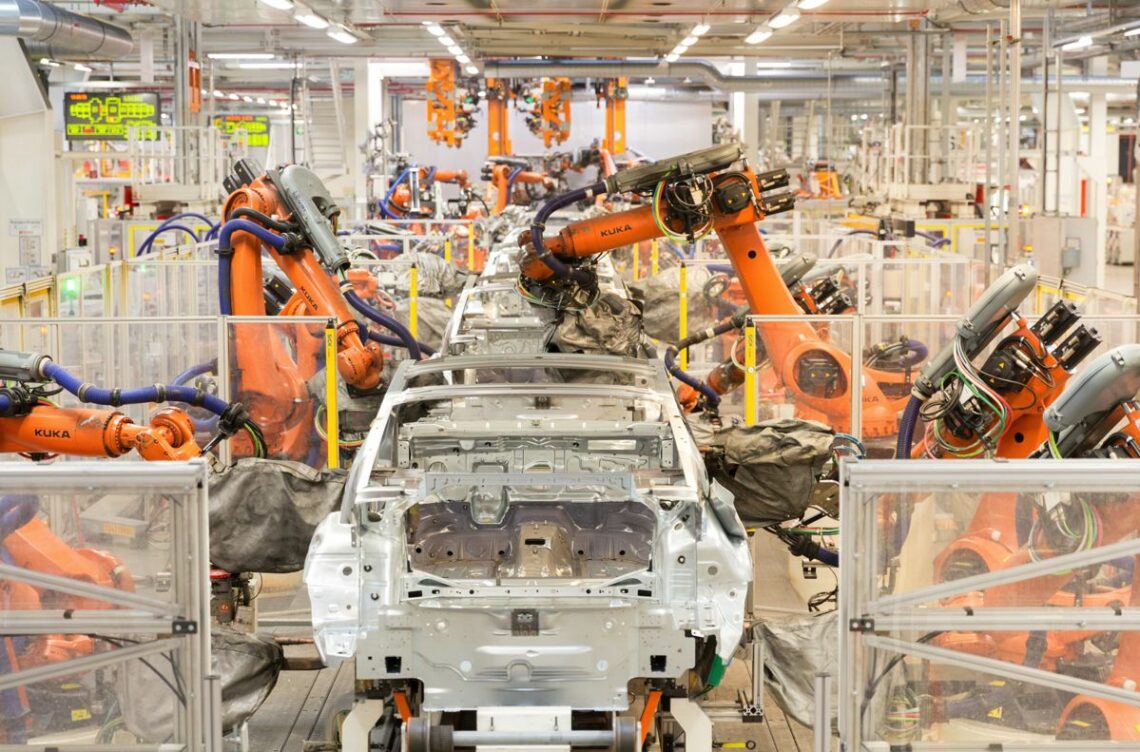No easy way back for U.S. manufacturing
President Donald Trump declared on October 1 that the new trade deal with Canada and Mexico signifies the return of the U.S. as a “manufacturing powerhouse,” which has indeed changed dramatically since 1992. But the complex and varied factors that have reshaped factory production in the U.S. cannot be summarily reversed.

In a nutshell
- U.S. manufacturing raised output but lost a quarter of its jobs in the past two decades
- Offshoring and automation have cost low-skilled jobs while creating more skilled ones
- Misguided government policies that hurt productivity growth are the real culprit
President Donald Trump declared on October 1 that the new trade deal with Canada and Mexico signifies the return of the United States as a “manufacturing powerhouse.” U.S. manufacturing has indeed changed dramatically since 1992, when the three countries signed their original trade pact. But the complex and varied factors that have reshaped U.S. manufacturing cannot be summarily reversed – notwithstanding the president’s resolve.
As a presidential candidate and since taking office, Mr. Trump has consistently vowed to replace the North American Free Trade Agreement (NAFTA), which he blames for shifting U.S. manufacturing to Mexico (among other lower-wage countries). In a bid to “level the playing field,” the new U.S.-Mexico-Canada Agreement (USMCA) calls for a minimum wage of $16 per hour on at least 40 percent of automakers’ “labor activities.” Tariffs would be imposed on cars with less than 75 percent North American content (NAFTA currently sets this threshold at 62.5 percent).
The U.S. has far fewer manufacturing jobs today than in decades past, both in absolute numbers and as a proportion of overall employment. The decades-long slide began in the late 1940s, when manufacturing accounted for 32 percent of American jobs, as compared with 8.5 percent today.
The steepest decline has occurred in the past two decades, when the number of U.S. manufacturing jobs fell by a whopping 26 percent – from 17.2 million in 2000 to 12.7 million today. But dramatic as this loss has been, domestic manufacturing output has actually increased. The value added in U.S. manufacturing totaled a record-high of $2.3 trillion in the first quarter of 2018, up from $1.7 trillion at the low point of the 2008 financial crisis.
The U.S. share of global manufacturing fell from 29% in the 1980s to 18% in 2016, mainly due to China’s rise.
Taken together, this employment decline and output gain signal improvements in manufacturing productivity. While output per hour for all nonfarm businesses increased by 170 percent since 1987, manufacturing productivity improved by 250 percent. However, the greatest productivity gains occurred in manufacturing between 1992 and 2004, before slowing greatly in recent years.
Eroding position
In a global economy, what matters is one’s competitive position relative to other nations. The U.S. share of global manufacturing (measured in value added) fell from 29 percent in the 1980s to 18 percent in 2016. Japan and Germany have likewise dropped from their peak shares in the 1990s. These declines are widely attributed to the major increase in Chinese manufacturing, which rose by 94 percent (in value-added terms) between 2008 and 2016. China now accounts for about 25 percent of global manufacturing, according to United Nations data.
For the U.S., 2010 marked a turning point – the year it was supplanted by China as the world’s largest manufacturing nation. While some of China’s manufacturing growth was fueled by the appreciation of its currency, the renminbi, against the U.S. dollar, many analysts attribute it above all to the extension of Permanent Normal Trade Relations (PNTR) and China’s admission into the World Trade Organization (WTO) in 2001.
PNTR status boosted Chinese exports to the U.S., while WTO membership lowered investment risk. The escalation of import competition in the U.S. and lower wages in China prompted manufacturers to relocate production to the latter country, or to import components produced by Chinese suppliers.
Meanwhile, automation in manufacturing was growing – particularly in the car industry, which accounted for 35 percent of global robotics sales in 2016, according to a study by the International Federation of Robotics. Penetration at U.S. carmakers now stands at 1,261 robots per 10,000 employees, compared with 2,145 in South Korea, 1,562 in Japan and 1,131 in Germany.
Collateral damage
These changes have stirred considerable debate about the degree to which the loss of U.S. manufacturing jobs in recent decades primarily resulted from offshoring or automation.
President Trump, of course, is among those who blame the reduction in manufacturing employment on rising import competition and a shift of production overseas. His administration’s imposition of steel and aluminum tariffs, and the tougher rules of origin for auto content, are intended to push production back to North America, in general, and the U.S., in particular.

Others give greater weight to the technological innovations that have displaced manual labor in pursuit of lower production costs. For example, the economist Michael J. Hicks, in a 2017 study, estimates that nearly 88 percent of the losses in manufacturing employment in recent years are attributable to productivity growth.
In fact, both offshoring and automation are crucial and intertwined. Researchers Teresa Fort, Justin Pierce and Peter Schott have documented an increase in computerization by manufacturers throughout the 1990s, followed by a big jump in the early 2000s. The trio also found greater job losses in regions with greater exposure to imports from China, particularly after 2000.
Growing automation
Employment displacement can be emotionally and financially shattering no matter the cause. But the march of technology is unstoppable: plows to rakes, weavers to jennies, pickaxes to excavators, blacksmiths to lathes, Gutenberg to Google. And global trade is irreversible; historian Peter Watson dates long-distance trade from 150,000 years ago.
To view job loss as inherently detrimental ignores the tremendous benefits Americans (and all nations) derive from innovation and trade. Ultimately, both improve living standards and increase national wealth (intellectual, scientific and cultural). And with such wealth come environmental improvements and extended life spans.
Automation in manufacturing has dramatically increased the demand for college-educated workers.
Consider, for example, that automation in manufacturing has dramatically increased the demand for college-educated workers to administer the various technologies. Jay Timmons, the president and CEO of the National Association of Manufacturers, estimates that manufacturers will need to fill some 3.5 million jobs in the next seven to eight years. “The challenge today isn’t a shortage of manufacturing jobs,” he said in a February 2018 address. “Far from it. The challenge is that the type of work in manufacturing is shifting.”
Offshoring and import competition also yield more benefits than drawbacks. Market competition provides consumers with greater choice at lower cost, while forcing U.S. companies to improve and look harder for export opportunities. Cheaper components from abroad also nurture entrepreneurs who otherwise could not afford market entry.
Productivity slump
But what of the slowdown in manufacturing productivity? That is the real problem. According to government figures, multifactor productivity declined by an annual average of 0.8 percent in 2007-2016, compared with an increase of 1.7 percent from 2000 to 2007.
Some analysts contend that gains from existing technology have largely been realized and that continued improvements will be marginal. But the broader problem is likely a slowdown in capital investment that would otherwise spark innovation. This is borne out by the slackening in R&D investment by manufacturers.
Economists point to a variety of government policies that have exacerbated (if not caused) the stall in productivity growth. Onerous regulation such as the Dodd-Frank Wall Street Reform and Consumer Protection Act and the Obama Administration’s healthcare overhaul have repressed access to capital and investment, while myriad environmental and energy regulations hinder business development and expansion. Subsidies, bailouts and protectionist schemes sustain industrial laggards that would otherwise fail – what the Organisation for Economic Co-operation and Development (OECD) terms “zombie” firms that often crowd out innovative start-ups.
Raising the costs of imports will punish consumers and undermine the competitive discipline of domestic firms.
Not to be overlooked is the dismal state of American public education, which fails to supply a sufficient number of qualified workers. In its latest assessment, the U.S. Department of Education reported that just 35 percent of eighth-graders and 36 percent of twelfth-graders were proficient in reading; 33 percent of eighth-graders and 23 percent of twelfth-graders were proficient in math; and 33 percent of eighth-graders and 21 percent of twelfth-graders were proficient in science.
Protectionist mirage
Manufacturing employment will continue to generate debate in the new Congress as lawmakers consider ratification of the USMCA (whose fate will largely depend on the outcome of November’s midterm elections). Having completed negotiations with Mexico and Canada, the Trump administration will turn to trade talks with Japan, the European Union and, eventually, China.
The president may boast about imposing protectionist measures such as tariffs, wage floors and rules of origin. After all, within days of the White House announcement on the new North American trade pact, executives for several foreign carmakers told The Wall Street Journal that they will now consider changing their supply chains to include more parts manufacturing in North America.
But protectionism is not going to make America great again. Raising the costs of imports will punish consumers and undermine the competitive discipline of domestic firms. The days of a middle class sustained by assembly line jobs are gone, and protectionism will not bring them back. Nor should we want it to.
The more beneficial trade policy would nurture global competition and technological innovation. For example, the tax reforms of 2017 will do much more to boost manufacturing than anything in the USMCA. According to the Manufacturers’ Outlook Survey, in response to the tax changes:
• 63 percent of respondents said they would spend more on facilities and equipment
• 54 percent said they would hire more workers
• Half planned to increase wages and benefits
The Trump administration’s regulatory reform agenda will likewise play an important role in easing constraints on investment and innovation.
President Trump would do well to heed the words of his predecessor Ronald Reagan, who told the nation in a 1982 radio address that when it comes to international trade:
We’re in the same boat with our trading partners. If one partner shoots a hole in the boat, does it make sense for the other one to shoot another hole in the boat? Some say, yes, and call that getting tough. Well, I call it stupid. We shouldn’t be shooting holes; we should be working together to plug them up. We must strengthen the boat of free markets and fair trade so it can lead the world to economic recovery and greater political stability.








